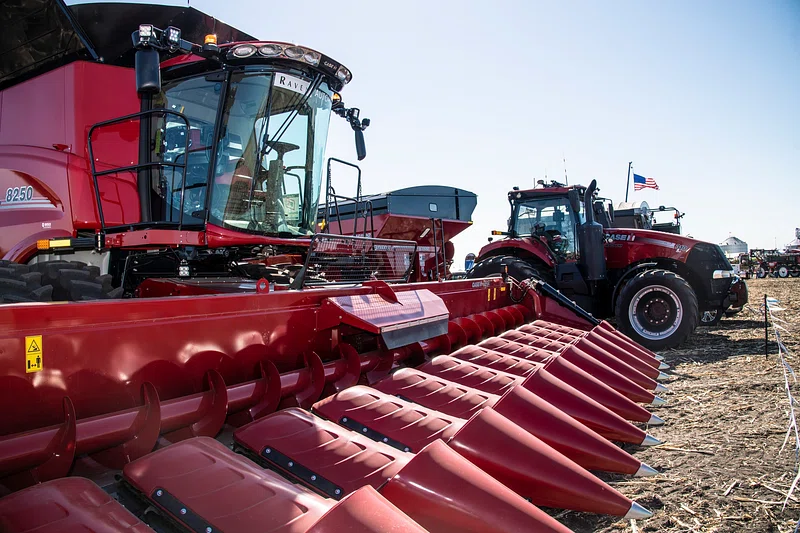As the harvest winds down and the fieldwork slows, it’s time to shift gears from running machines hard to putting them to rest. Proper winterization and storage are essential tasks that should not be overlooked. Without it, tractors, combines, and other equipment are more likely to face corrosion, deterioration, costly repairs, or surprise failure when you fire them up again in the spring.
Here’s a breakdown of what should be done, how best to store, and why it’s important.
Why It Matters
Cold weather, moisture, long idle periods, and exposure to residues like mud, crop debris, or chemicals all take a toll on farm equipment. Rust, seal degradation, and battery failure are some of the most common results of improper storage. A machine that receives proper attention before storage will run smoother and last longer. For example, leftover crop material inside a baler or combine can trap moisture and cause corrosion. Batteries also tend to die if neglected during the off-season. In short, the time spent on maintenance now pays dividends later with less downtime, fewer emergency repairs, and better resale value.
Pre-Storage Maintenance Checklist
Before you pull the equipment into winter rest, go over this checklist. It applies broadly to tractors, combines, and other farm machines, though you should adapt it to your specific make and model.
1. Clean and Inspect Thoroughly
Start by removing all crop residues, dirt, and mud from the engine compartments, undercarriage, PTO areas, and header components. Wash the machine and let it dry completely before inspecting belts, hoses, seals, and rubber boots for cracking or wear. Any rust spots or chipped paint should be treated with rust protectant or touch-up paint to slow corrosion.
2. Fluid and Lubricant Service
Change the engine oil and oil filter before storage so that contaminants don’t sit in the system over winter. Check the antifreeze and coolant mixture to make sure it offers proper freeze protection. Review all fluid levels including hydraulic, transmission, and PTO gearbox fluids. Grease every pivot point, joint, linkage, loader arm, and hitch point to protect them from moisture and friction damage while idle.
3. Fuel, Filters, and Battery
Fill the fuel tank to reduce condensation and add a stabilizer if the machine will sit for several months. Change or clean the fuel and air filters, and drain any water from separators to prevent freezing or gelling. Batteries deserve special attention. Either disconnect and remove them or ensure they remain charged and maintained throughout the winter. Clean the terminals, coat them to prevent corrosion, and if possible, store batteries indoors on a maintainer.
4. Tire, Track, and Undercarriage Care
Check tire pressures and remember that cold weather will naturally lower them. Prolonged storage can cause flat spots, so consider storing the machine on blocks or rotating the tires occasionally. For tracked or driven-wheel machines, clean and inspect the undercarriage and relieve tension if recommended. Make sure all wheel bearings and idlers are properly lubricated and that no debris is trapped between moving parts.
5. Storage Preparation
Indoor storage in a barn or shed is ideal because it protects from moisture, UV exposure, and temperature swings. If outdoor storage is the only option, use a heavy-duty, breathable tarp rather than plastic, which traps condensation. Raise or secure attachments, disconnect sensitive electronics, and seal any openings that might allow moisture or pests to enter. Clean up the storage area to discourage rodents, and consider repellents if necessary. Before finishing, record your maintenance steps, fluid levels, and operating hours so you have a reference for spring.
Best Practices for Storage
Store the machine on a dry, level surface to prevent rust from forming underneath. When possible, slightly raise the machine or relieve pressure on the tires to avoid flat spots. Allow for some airflow even when covered to reduce condensation buildup. Throughout the winter, check the equipment once or twice for leaks, tire pressure, and rodent activity. A quick inspection can save major repair time later. When spring arrives, go through a wake-up checklist to verify all fluids, belts, and systems before returning to work.
Focus Areas by Machine Type
Tractors benefit from a full review of the engine oil, coolant, hydraulics, PTO, tires, and battery. Combines and other harvest machines require a deep clean to remove chaff, straw, and residue from headers, threshing units, and hoppers, since trapped debris can hold moisture and corrode metal. Hay and forage equipment, including balers, should have all hay and crop material removed from chambers and rollers. Chains and sprockets should be greased and protected from moisture during storage.
Why Skipping This Will Cost You
Skipping these steps leads to real problems when it’s time to start working again. Seals can dry out and leak, corrosion can weaken components, and electrical connectors can fail. Batteries left unmaintained often need replacement, and fuel systems can become contaminated or clogged. Even small issues like a cracked belt or hose can turn into major downtime during planting or harvest.
Final Thoughts
Taking the time now to properly winterize and store your equipment ensures that your machines will be ready when you need them most. It protects your investment, reduces surprise repairs, and keeps your operation running smoothly. At Tractor Tuesday we like to say the best harvest begins with the care you give your machines in the off-season.



Leave a Reply